On This Date In History
On November 4, 1979, student followers of the Ayatollah Khomeini send shock waves across America when they storm the U.S. embassy in Tehran. The radical Islamic fundamentalists took 90 hostages. The students were enraged that the deposed Shah had been allowed to enter the United States for medical treatment and they threatened to murder hostages if any rescue was attempted. Days later, Iran’s provincial leader resigned, and the Ayatollah Khomeini, the leader of Iran’s fundamentalist revolutionaries, took full control of the country, and the fate of the hostages.
Two weeks after the storming of the embassy, the Ayatollah began to release all non-U.S. captives, and all female and minority Americans, citing these groups as among the people oppressed by the United States government. The remaining 52 captives were left at the mercy of the Ayatollah for the next 14 months.
President Jimmy Carter was unable to diplomatically resolve the crisis, and on April 24, 1980, he ordered a disastrous rescue mission in which eight U.S. military personnel were killed and no hostages rescued. Three months later, the former shah died of cancer in Egypt, but the crisis continued. In November 1980, Carter lost the presidential election to Republican Ronald Reagan. Soon after, with the assistance of Algerian intermediaries, successful negotiations finally began between the United States and Iran.
On January 20, 1981, the day of Reagan’s inauguration, the United States freed almost $3 billion in frozen Iranian assets and promised $5 billion more in financial aid. Minutes after Reagan was sworn in, the hostages flew out of Iran on an Algerian airliner, ending their 444-day ordeal.
On November 4, 1995, Israeli Prime Minister Yitzhak Rabin is fatally shot after attending a peace rally held in Tel Aviv’s Kings Square in Israel. Rabin later died in surgery at Ichilov Hospital in Tel Aviv.
The 73-year-old prime minister was walking to his car when he was shot in the arm and the back by Yigal Amir, a 27-year-old Jewish law student who had connections to the far-right Jewish group Eyal. Israeli police arrested Amir at the scene of the shooting, and he later confessed to the assassination, explaining at his arraignment that he killed Rabin because the prime minister wanted “to give our country to the Arabs.”
Born in Jerusalem, Rabin was a leader of the Arab-Israeli war of 1948 and served as chief-of-staff of Israel’s armed forces during the Six-Day War of 1967. After serving as Israel’s ambassador to the United States, Rabin entered the Labour Party and became prime minister in 1974. As prime minister, he conducted the negotiations that resulted in a 1974 cease-fire with Syria and the 1975 military disengagement agreement between Israel and Egypt. In 1977, Rabin resigned as prime minister over a scandal involving his holding of bank accounts in the United States in violation of Israeli law. From 1984 to 1990, he served as his country’s defense minister.
In 1992, Rabin led the Labour Party to election victory and became Israel’s prime minister again. In 1993, he signed the historic Israeli-Palestinian Declaration of Principles with Palestinian leader Yasir Arafat and in 1994 concluded a formal peace agreement with the Palestinians. In October 1994, Rabin and Arafat shared the Nobel Peace Prize, along with Israeli foreign minister Shimon Peres. One year later, Rabin was assassinated. Peres succeeded him as prime minister.
On November 4, 1956, a spontaneous national uprising that began 12 days before in Hungary is viciously crushed by Soviet tanks and troops. Thousands were killed and wounded and nearly a quarter-million Hungarians fled the country. The problems in Hungary began in October 1956, when thousands of protesters took to the streets demanding a more democratic political system and freedom from Soviet oppression. In response, Communist Party officials appointed Imre Nagy, a former premier who had been dismissed from the party for his criticisms of Stalinist policies, as the new premier. Nagy tried to restore peace and asked the Soviets to withdraw their troops. The Soviets did so, but Nagy then tried to push the Hungarian revolt forward by abolishing one-party rule. He also announced that Hungary was withdrawing from the Warsaw Pact (the Soviet bloc’s equivalent of NATO). On November 4, 1956, Soviet tanks rolled into Budapest to crush, once and for all, the national uprising. Vicious street fighting broke out, but the Soviets’ great power ensured victory. At 5:20 a.m., Hungarian Prime Minister Imre Nagy announced the invasion to the nation in a grim, 35-second broadcast, declaring: “Our troops are fighting. The Government is in place.” Within hours, though, Nagy sought asylum at the Yugoslav Embassy in Budapest. He was captured shortly thereafter and executed two years later. Nagy’s former colleague and imminent replacement, János Kádár, who had been flown secretly from Moscow to the city of Szolnok, 60 miles southeast of the capital, prepared to take power with Moscow’s backing. The Soviet action stunned many people in the West. Soviet leader Nikita Khrushchev had pledged a retreat from the Stalinist policies and repression of the past, but the violent actions in Budapest suggested otherwise. An estimated 2,500 Hungarians died and 200,000 more fled as refugees. Sporadic armed resistance, strikes and mass arrests continued for months thereafter, causing substantial economic disruption.

















No comments:
Post a Comment